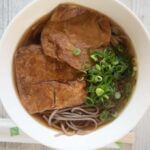
Kitsune Soba is one of the very traditional noodle soups with just seasoned aburaage (fried tofu) and green onions as toppings. The sweet aburaage on the noodles is so delicious.
By using a vegetarian dashi stock, you can make it a perfect vegan noodle soup.
Don't forget to see the section 'MEAL IDEAS' below the recipe card! It gives you a list of dishes that I have already posted and this recipe that can make up a complete meal. I hope it is of help to you.
- 200g/7oz dried soba noodles (note 1)
- 600ml/1.3pt dashi stock
- 4 tbsp soy sauce
- 3 tbsp mirin
- 500ml/1.1pt boiling water (can be more)
- 2-3 tbsp green onion finely chopped
- Shichimi tōgarashi (optional)
-
Cut each aburaage in the middle to make 4 square pieces.
-
Place the aburaage pieces in a sieve or a colander and pour half of the boiling water over them. Turn the aburaage pieces over and pour the rest of the boiling water over them.
-
Cool them down a bit, then squeeze the water out of the aburaage pieces.
-
Put the aburaage pieces and the rest of the Seasoned Aburaage ingredients into a small saucepan and bring it to a boil.
-
Reduce the heat to medium low and cook for about 10 minutes with a drop lid on until the liquid almost evaporates. Turn the aburaage pieces over halfway through cooking to evenly stain the aburaage with a dark brown colour.
-
Turn the heat off and leave until required.
-
Bring water (not in Ingredient list) in a large saucepan to a boil (note 4). Put the dried buckwheat noodles in the boiling water and stir for about 15 seconds, ensuring that each strand is separated.
-
Boil for the duration that is recommended for your dried buckwheat noodles (note 4).
-
Drain the noodles into a colander and rinse well under cold running water until the noodles are completely cooled down. Shake the colander well to remove the excess water.
-
Put the Broth ingredients into a saucepan and bring it to a boil.
-
Turn the heat off (note 5).
-
Fill the boiling water in a separate saucepan or a bowl which can easily fit in a medium-size sieve.
-
Place half of the soba noodles in the sieve and dip the noodles in the hot water for 10 seconds or so to warm them up.
-
Shake the sieve well to drain water off the noodles and transfer the noodles to a serving bowl.
-
Repeat the steps 2 and 3 for the second serving (note 6).
-
Pour the broth into each bowl, place two aburaage pieces each on the noodles, and scatter the green onions next to the aburaage.
-
Serve immediately with shichimi tōgarashi, if using.
1. I usually use 100g/3.5oz of dried soba noodles for a serving. However, my soba pack contained 250g/8.8oz of dried soba and it indicated 2 servings. I think 125g/4.4oz of dried soba noodles makes a large serving, but it might be just right if you are very hungry or a big eater.
2. Seasoned aburaage freezes well. You can make many of them and stock up in the freezer. It will speed up the cooking process.
The flavour of seasoned aburaage is very similar to the aburaage used for Home-made Inari Sushi (Inarizushi). If you want a short cut, you can buy a pack of the seasoned aburaage pouches that I used in my recipe Quick Inari Sushi (Inarizushi).
3. If you are a vegetarian, you can use a vegetarian dashi such as konbu dashi and shiitake dashi.
If you have a sweet tooth, you can add some sugar.
4. The recommended amount of water to boil the noodles and the duration to boil them is usually written on the back of the package. The cooking duration does vary depending on the brand of the noodles and the percentage of buckwheat included in the dried noodles.
If you don’t have instructions, boil in a generous amount of water and check the doneness by eating a strand from time to time. The centre of the noodle should be just cooked through.
5. It would be good if you make it just in time to serve. If you make a broth too early, bring it to a boil again.
6. I warmed the noodles per serving because it was easier to handle. But you can warm all of the noodles at once, then halve them to serve if you prefer.
7. If you want to make kitsune udon, instead of Kitsune Soba, replace the soba noodles with udon noodles.
As mentioned in my post, tanuki soba is topped with tenkasu, instead of seasoned aburaage. By swapping the topping and noodles, you can make tanuki soba or tanuki udon using this recipe.
To add colour to the dish, you can put a couple of slices of kamaboko or narutomaki.
8: Nutrition per serving. It is assumed that you drink all the broth. If you only drink half of it, you can cut back sodium by almost 50%.
serving: 498g calories: 320kcal fat: 18g (28%) saturated fat: 3.2g (16%) trans fat: 0.0g polyunsaturated fat: 5.8g monounsaturated fat: 7g cholesterol: 3mg (1%) sodium: 2664mg (111%) potassium: 702mg (20%) carbohydrates: 23g (8%) dietary fibre: 1.1g (4%) sugar: 20g protein: 16g vitamin a: 2.1% vitamin c: 3.3% calcium: 15% iron: 11%